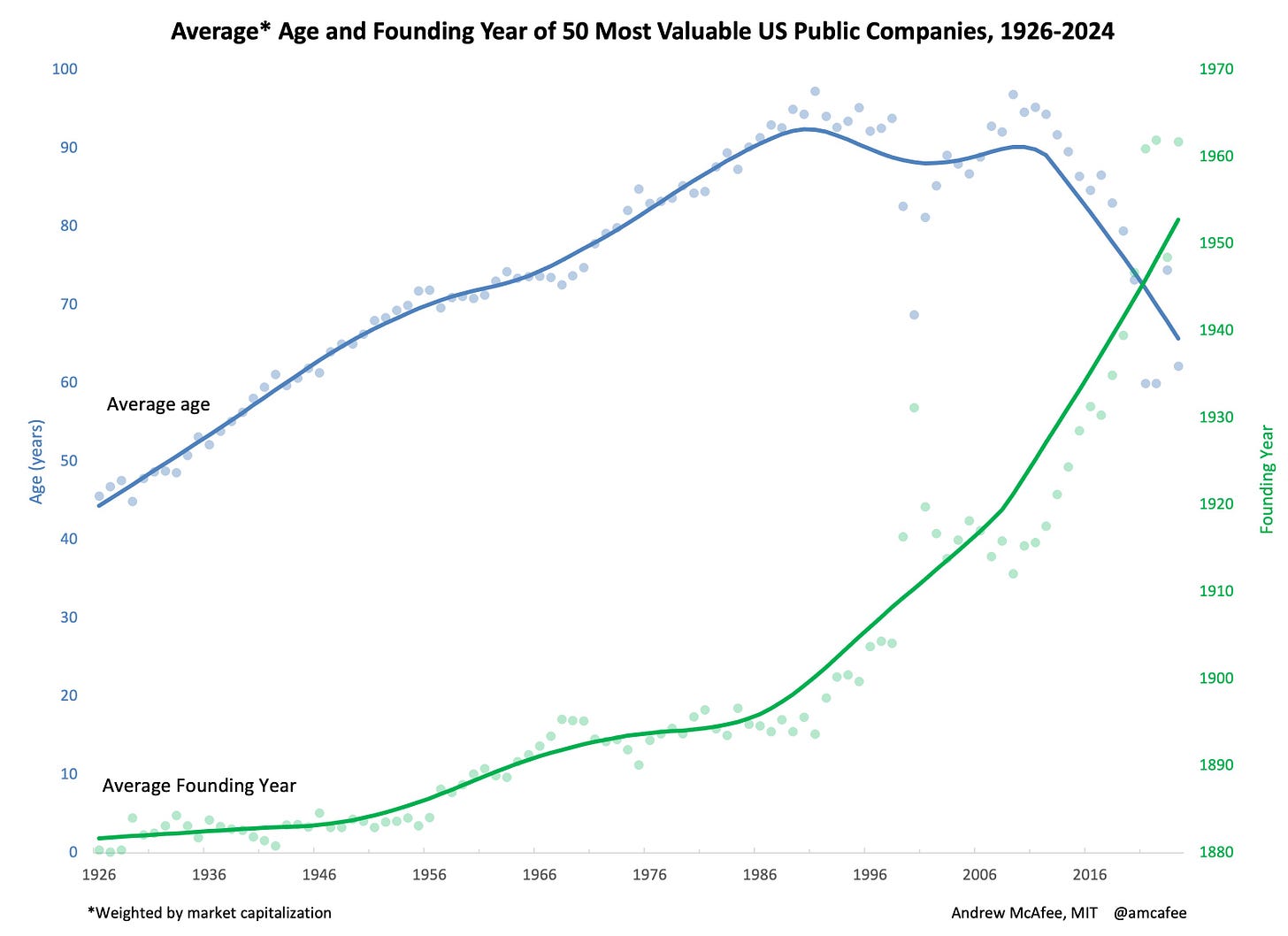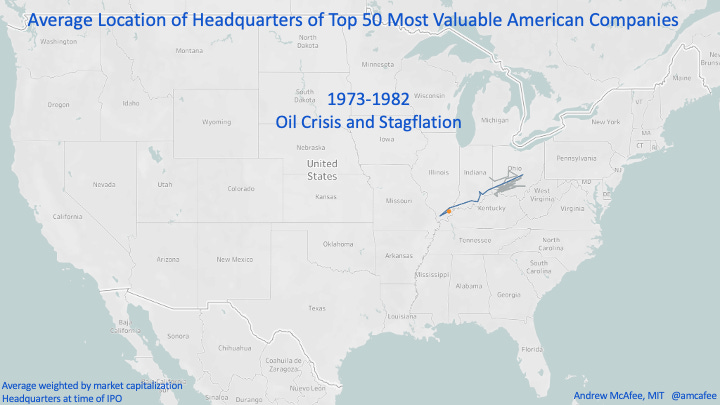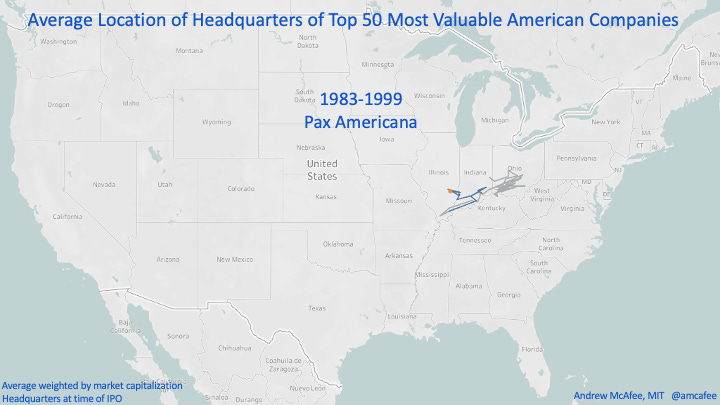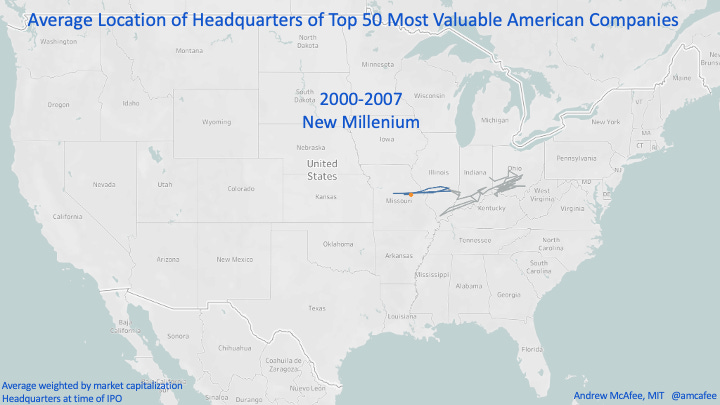A couple posts ago I stated the claim that’s been at the center of my recent research and writing: a bold new chapter in capitalism is at hand!
I supported that claim in part with the chart below, which shows a strong and unprecedented youth movement among America’s most valuable companies:
Is this youth movement shaking things up across the country? Have big bold extraordinarily valuable young companies been springing up in the concrete canyons of Manhattan and along the Chicago lakefront? Have they been incubated in Motown or Beantown?
To a remarkable extent, they have not. Most of America has been on the sidelines of the massive change I keep banging on about. The epicenter of this change is far away from all the traditional hotspots of the US economy.
To see what I’m talking about, let’s look at a series of maps showing how the geographic center of America’s big companies has moved over the past century-ish (the same timespan shown in the graph above). These maps underscore my “we’ve never seen anything like this before” message.
Good data exist on the market capitalizations of US public companies going back to 1926, so let’s start there. My Hoosier heart swells with pride every time I look at the map below because it shows that the headquarters of the American large-company economy back then was in Indiana:
Now of course America’s industrial might wasn’t concentrated in Indiana in the Roaring Twenties. It was concentrated in New York and Pittsburgh and Detroit and Chicago. And it was concentrated in Oil companies and railroads, which were headquartered all over the country. The average of the latitutes and longitudes of those 50 HQs just happened to fall in eastern Indiana.
The 20th Century? Kinda Boring, Really
And then it stayed in that neighborhood for quite a while. I divided up the years since 1926 into arbitrary eras, then legitimized them with largely made-up labels, then graphed how the average top 50 HQ moved around within each era.
During the Great Depression it moved east a bit and danced around central and southern Ohio:
Then came World War II, which has been widely acknowledged as a big deal — the kind of thing that could shake up an economy. But it didn’t move the headquarters much at all:1
Neither did the baby boom, suburbanization, Rock and Roll, or any of the other salient midcentury developments:
Not even the hippies did:
America’s top 50 HQ wasn’t much affected by the arrival of the hippies’ mind-altering substances. But the withdrawal of cheap oil did turn into an economy-altering event:
The oil crisis caused the top 50 HQ to move sharply toward Texas. For the rest of the 20th century, it wandered around the new neighborhood without making any more big moves:
Over the final 73 years of the 20th century,2 then, the top 50 HQ moved less than 200 miles. Whatever competitions took place among America’s largest companies during that time, whatever new winners and losers emerged, they didn’t much affect the country’s geographic balance of private-sector power.
And Then Came the 21st Century
Even after the dot-com bubble burst in early 2000, the top 50 HQ kept heading west in the following years:
As smartphones and Web 2.0 spread the action kept moving in exactly the same direction:
It’s not that smartphones stopped being important in 2017, so why did I break the timeline there? Because that year marked a seminal yet little-remarked turning point in American business history. It’s when total US corporate investment in digital gear (hardware and software) for the first time surpassed investment in all other equipment combined.
Starting in 2017 America became a digital-first economy. It’s been one ever since, and it’s not even close any more. Spending on digital equipment is currently more than 70% greater than spending on all other equipment combined, and the corporate thirst for all things digital shows no signs of abating (real spending on all other equipment, meanwhile, is slightly declining):
In this new digital-first era, the US top 50 HQ has been getting pulled toward Northern California as if by a magnet:
Over the last three-quarters of the 20th century, the US top 50 HQ moved by less than 2.5 miles per year. So far in the first quarter of the 21st century, it’s been moving more than 18 times faster than that, in a close-to-due-west beeline.
Substack tells me this post is getting long, so I’ll end it with a question we’ll spend time on in future posts:
Why has rest of the country missed out so thoroughly on the biggest business change of the past 100 years?
Yes, I know the US didn’t formally enter WWII until 1941.
Yes, I know that 2000, not 1999, was the final year of the 20th century.

















Getting excited about geographic average of corporate HQ is definitely geek. But, since we are on the subject, it is interesting that the 2008-17 center coincided almost exactly with the geographic center of the US, Lebanon, Kansas. Pretty sure that this does not mean that corporate wealth was evenly distributed, even if the HQ buildings were.
This is an interesting article, but is it really the “the biggest business change of the past 100 years?”
That seems like a little bit of hyperbole. The maps were fascinating, though.